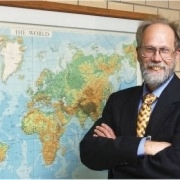 Cerling was born in Illinois in 1949. During high school, his family moved to Iowa, where they lived near the Mississippi River. He was always interested in science and engineering and worked with his father to devise boat docks that could handle rapid rises in river level and other projects involving their small, family-owned marina. These days, ThureÔÇÖs scientific pursuits have taken him to all seven continents, where he has used isotopes as tools to study EarthÔÇÖs geology and biology. He has analyzed subjects as varied as the formation of the Grand Canyon, our earliest human ancestry, and the nutrition of modern animals (including his own diet). A distinguished professor of geology, geophysics, and biology at the University of Utah, Salt Lake City, Cerling was elected to the National Academy of Sciences in 2001 and recently published his Inaugural Article, which discussed the use of isotopes contained in the tail hairs of African elephants to determine the last 6 years of their eating habits. He enjoys working with Wildlife Services in developing countries, asserting that the tools developed over the past 40 years can be applied to addressing conservation problems around the world.
Cerling was born in Illinois in 1949. During high school, his family moved to Iowa, where they lived near the Mississippi River. He was always interested in science and engineering and worked with his father to devise boat docks that could handle rapid rises in river level and other projects involving their small, family-owned marina. These days, ThureÔÇÖs scientific pursuits have taken him to all seven continents, where he has used isotopes as tools to study EarthÔÇÖs geology and biology. He has analyzed subjects as varied as the formation of the Grand Canyon, our earliest human ancestry, and the nutrition of modern animals (including his own diet). A distinguished professor of geology, geophysics, and biology at the University of Utah, Salt Lake City, Cerling was elected to the National Academy of Sciences in 2001 and recently published his Inaugural Article, which discussed the use of isotopes contained in the tail hairs of African elephants to determine the last 6 years of their eating habits. He enjoys working with Wildlife Services in developing countries, asserting that the tools developed over the past 40 years can be applied to addressing conservation problems around the world.
